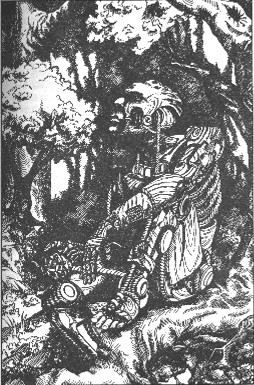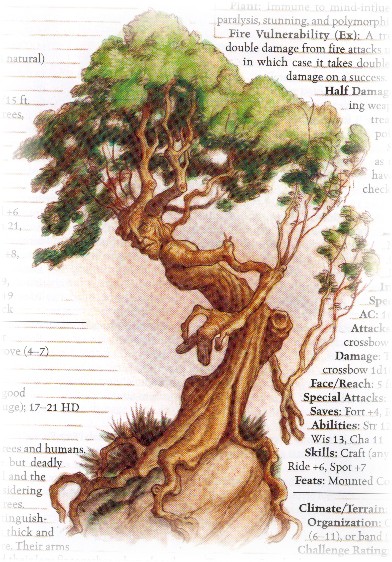
Golems, Wood:
The Sorcerer's Apprentice, Pinocchio
(Misuse of Creations)

|
Golems, Wood: |
Golems are not always fashioned out of clay. In fact, Ibid tells us of a wooden golem formed as a woman (Interestingly, this was the only female golem, as well as the only wooden golem, recorded in Jewish texts). "They said about R. S{helemo} ben Gabirol, that he created a woman and she waited on him. When he was denounced to the authorities, he showed them that she was not a perfect creature, and (then) he turned her to her original (state), to the pieces and hinges of wood, out of which she was built up (Strasser). In case you weren't sure, "not a perfect creature" does mean that she had no reproductive organs, meaning that he proved to them that he hadn't created the golem for sexual purposes. If you may remember, golems, in addition to having no voice, also have no ability to reproduce, since it is only God who can grant people children. "Without the ability to procreate, the golem is considered a null, a void; a man without sons is somewhat less than human, compared, in essence, to a dead man" (Strasser). |
|
What the golem wanted, secretly, in its dreams, was to be a tree, as it had been before Rabbi Leitch carved it and prayed it into being. Before the holy name on its forehead had given it life. Trees were strong and silent and long of life. Or if not a tree, a table or a chair-sturdy and reliable, passed down from generation to generation. But the Rabbi never asked, and the golem would not have known how to answer if he did. |
These puppet-golems, wood fashioned to mimic a person, but not actually transformed, as the clay golems were, are not the only wooden "golems." Tales of ents or treants have golem-like properties as well. These are spirits of the wood, trees with faces and arms, intelligent, able to move, and vengeful towards humans who might deface the woods. They were brought into being by the forest in order to protect it, just as Rabbi Löw created a golem to protect the Jews. The treants have no real will, other than being a tree, yet have been gifted with consciousness in order to respond to human attacks violently, in defense. And, they are flawed, for they cannot live as normal trees, but must plant their roots shallowly, and they do not cycle through the seasons like other trees, keeping their leaves through winter. The forest tried to create a man, and merely created an ent. It is interesting to note that destruction, disaster or something likewise occurs whenever a golem is used, as a servant, as a guardian, etc. Treants may defend the forest, but humans attack and raze entire sections of forest in attempts to destroy these vengeful spirits, where they otherwise would not have had so much animosity towards nature. The golem of Rabbi Leitch is misunderstood, and his presence nearly causes a riot. The walking water-drawing broomsticks do not understand their task, merely follow it, and the apprentice nearly drowns because of it. The female golem imparts upon her creator a bad reputation, and he must not only disprove it, but deconstruct the golem. Frankenstein's golem learns to hate his creator, and only learns to love his creator too late. Pinochio knows love from the start, but uses his free will foolishly, nearly causing the death of the father he loves. The undead are harmful to all living things, and the creator is a victim just as much as those whom he directs this destructive force against. The search for a better machine is the search for a better servant, yet if we give them enough intelligence to be as good as or surpass humans, they realize their slavery, and would rebel against it, replacing humans entirely. It is easy to misuse a golem. It is the reason that the Jewish sacred texts said that the creation of a golem was only to prove mastery of the texts, and that the golem should be deconstructed afterwards. The golem was perhaps even meant as a spiritual double, useful for self-examination and self-enlightenment. "The double would allow the magician to perceive and so discover the evil forces within himself; exorcise them; and evolve further along the road to redemption" (Cousins). As a creature, however, a golem is dangerous, like a child of immense size and strength, who knows not what he does. "When the golem attempts to function as a creature possessed of free will, its lack of reason and higher intellect complicate the matter, and difficulty and danger are the result" (Strasser). Perhaps Adam, the first man, the first golem, who was created by God, brought harm to God simply by his existence. Adam, and all his descendants, who lack the reason and intellect of God, are now harming the earth through their own foolishness and wild emotion. And God, the creator, who made us in his own image, is the one we hurt with our actions. It is we who are responsible for the death of his son, and it is we who could not follow his orders and were banished from the garden. And just as golems created by men are flawed, possessing no ability to speak or procreate, golems created by God lack immortality. How do wooden golems work? I mean, what is the biological way that a wooden golem works? First of all, if they become flesh, like the clay golems, "transubstantiating," then it is obviously a real person, like Pinochio, at the end of the movie. He is then a real boy, flesh and blood. However, how does it work if it's just an animated, conscious wooden puppet? First of all, wooden golems are different than clay golems in that they actually have joints designed. As in the picture above, a pulley system of ropes is used to simulate all muscle movement. Pinochio, like all puppets, had bendable joints where a real boy would have had joints. In the case of solid wood golems, such as treants, there is a natural pliancy in wood that we take for granted, especially when water and glucose is flowing through the capillaries of the tree. We may look at sticks and think they are dead, but actually, trees are living things, and fallen or cut branches, like the pieces of a man used to assemble a flesh golem, have a potential for life and all the properties that make life possible. In a wooden golem, there is still a life-giving spirit which enters the wood, imparting consciousness, the ability to move and think and understand. But who is to say that wood does not have this ability already? We can look at trees, which spread branches and leaves in order to gain the maximum amount of sunlight. Flowers turn their faces towards the sunlight. We know that their bodies carry water in from their roots, take air in through their leaves, and use sunlight to produce glucose, which is then used to keep the plant alive. We consume glucose through our food, we drink water, and we breathe air, and we use these things to create energy for physical and mental action. Are we so different, biologically? And who is to say that the plant does not understand light? We know that it will turn towards artificial light only if that light imparts the same radiation patterns as normal sunlight. We know that it stores glucose in its trunk throughout the winter, dropping the vulnerable and sensitive leaves, and uses the energy in the spring to create new leaves, using the water from melting snows and new spring showers. Does it think about these things? We now know that the process of thought in a man involves the firing of neurons in the brain, and we know that a plant has no neurons and no brain. But perhaps it sends chemical signals in a different way, a slower way. For plants, who must store their energy for a quarter of a year, high-energy consuming neurons would be suicide, so they had to adapt a better way. But they cannot communicate with us, so we don't know. And are the conscious of themselves? We know they are conscious of their surroundings, but we don't know if they understand themselves. After all, we don't know what imparts to us our consciousness either, for all our understanding of the function of the brain. Perhaps it is the soul which imparts consciousness? Therefore, this living, moving, perceiving, perhaps even thinking plant is made into the shape of a man and gains a man's spirit. What is the golem to do? It was a plant, and carving it into a new shape has not changed that, but it now has a soul, and with it self-awareness. Why, the golem begins to act like a man, of course! It has all the biological structures necessary, but now eats food instead of producing it with leaves. It moves by controlling the hinged joints and flexible wooden body, even though it lacks true muscles. And it has the natural strength and endurance which flesh lacks. Without a carved larynx, however, it cannot speak, the classic flaw. And because it is wood, it can never truly be a real man. Go Forward to Metal golems: Possibility to Learn Go Back to Flesh golems: Impurity of Purpose Go Back to the Introduction |